

Alternative ways to improve abdominal strength and core stabilisation
Les Archer demonstrates core-stabilisation exercises for experienced athletes whose sports require dynamic balance.
There have been, and I suppose it will be many more articles on the subject of developing core strength. This article looks at just a few ideas I have developed to help improve the stability amongst sportsmen and women who have done a reasonable level of stability training. What I have done is try to change the static prone bridge or plank to a more dynamic exercise. The sports that I coach require the players and athletes to have superior stability or dynamic balance while applying force. In track and field, the rotational forces that the core is exposed to need to be developed to such an extent that they will be minimised when running.
This also applies to rugby and hockey, where running is the major activity before play takes place. I also believe that it is not always possible for athletes or players to get their expensive equipment, so the following will hopefully help in this regard. Important to note that the tummy is pulled in and the gluteus muscles are squeezed at all times. Keep the body still and as straight as possible.
Skateboards: Prone position.
Keep the hips parallel to the floor at all times.
Movement: Forward and backwards
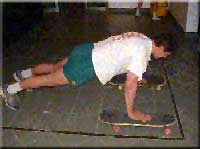 |
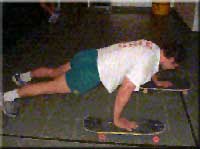 |
Movement: Lateral
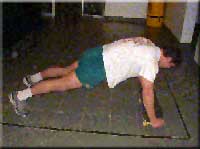 |
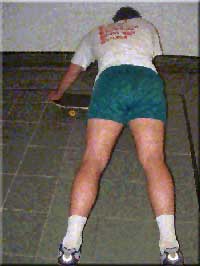 |
In place of the skateboards, you can use rowing machines just as well. However, the skateboards will benefit you more as they bring a more advanced level of instability into the exercise, as both sides are worked 'independently.'
Weights: Prone position
NOTE: Moving the weights forward and backwards places huge amounts of pressure on the lower back and abdominals.
Start by moving the weights forward and backward with small movements. Once this can be done without any discomfort, pull the weights more towards your abdominals than forward. This will place less stress on your back. The further forward you move the weights, the more stress is placed on the lower back.
Once again, keep the hips parallel to the floor.
Movements: Forwards and backwards
Muscles involved: These movements work the obliques.
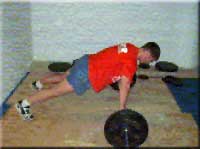 Start position |
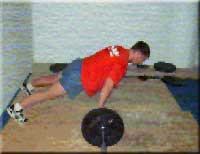 Position two |
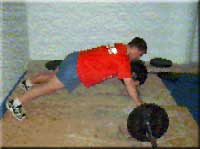 Position three |
Sideways movement:
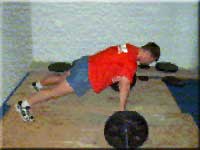 Start position |
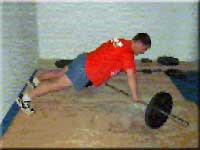 Position two |
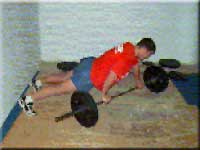 Position three |
It is vital to keep the gluteus muscles squeezed and the tummy pulled in. The body should be kept as straight as possible.
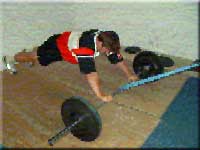 To advance from this position, you would require TheraBand. Place it
around the bar and stretch it to a point where it is difficult for the person
to keep the bar still. Now, with normal movement forward and backwards, do the
exercises.
To advance from this position, you would require TheraBand. Place it
around the bar and stretch it to a point where it is difficult for the person
to keep the bar still. Now, with normal movement forward and backwards, do the
exercises.
If you need to develop one side more than the other, place the TheraBand on that side. One could either resist the backwards (To this side) pull or the forward (To this side) pull. Once the person has mastered this, a further TheraBand could be used, resisting both the forward and backwards movement. I am sure there are many alternative ways to improve core strength and stability, but in my experience, this has been one of the hardest for rugby players, field hockey players, and track and field athletes.
Important: THIS IS NOT FOR THE WEAK.
When performing these exercises, you have to keep your tummy tucked in at all times. As a rugby strength and conditioning coach, I found that this is a good exercise for the front-rowers, where it is important to have a strong core when it comes to scrummaging. The repetitions and sets will depend on the athlete's level of core strength and stability.
Article Reference
This article first appeared in:
- ARCHER, L. (2004) Alternative ways to improve abdominal strength and core stabilisation. Brian Mackenzie's Successful Coaching, (ISSN 1745-7513/ 12 / May), p. 9-10
Page Reference
If you quote information from this page in your work, then the reference for this page is:
- ARCHER, L. (2004). Alternative ways to improve abdominal strength and core stabilisation [WWW] Available from: https://www.brianmac.co.uk/articles/scni12a7.htm [Accessed
About the Author
Les Archer is a track and field coach in South Africa with experience from schools to the Olympics, specialising in sprints and long jump. He is also the current strength and conditioning coach for the Golden Lions rugby union in South Africa.